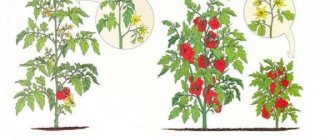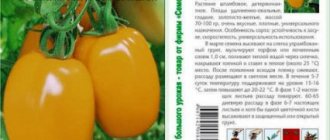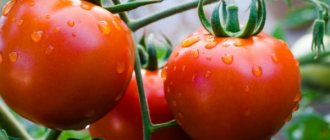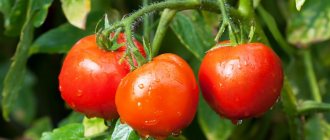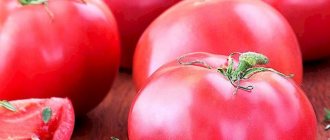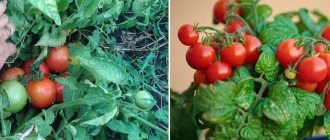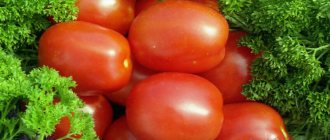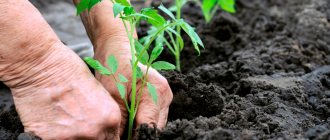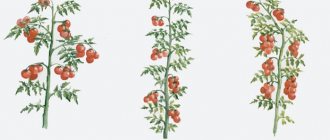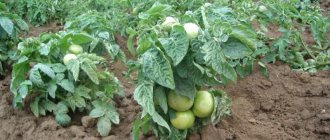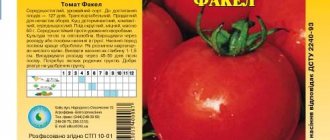Agricultural technology
As you know, tomatoes can be grown:
- using seedlings;
- using the seedless method.
Both have an economic rationale. An arid climate requires the presence of seedlings and greenhouse conditions. Soft seaweed is native to tomato crops; here you can get by by sowing seeds in open beds.
The soil should be light and nutritious. A mixture of humus, sand and earth is ideal. Usually the soil is prepared in late autumn, spreading humus throughout the area. During the winter and part of spring it rests, some of the nutrients are absorbed into the soil with the help of melt water. After this, complex fertilizers are added and dug up. All that remains is to choose the right time to plant seedlings, care for them and wait for the harvest.
The soil characteristics in the Krasnodar region must be taken into account when planting. Arid steppe lands consist of carbonate, leached chernozems. Mineral feeding is needed here.
Complex fertilizers are usually used - the risk of overfeeding the plant with a single element is reduced. Sometimes there is a need for spot feeding of tomato varieties for the Krasnodar Territory - open ground allows the application of fertilizers using liquid or dry methods.
For these purposes they usually use:
- superphosphate (phosphorus content 20%) or double superphosphate (45%);
- potassium nitrate;
- urea
To plant bushes in such soil, it is pre-treated with all three types of fertilizers. The recommended ratio is 1:1:1. After the first fruits appear, the proportion is changed - 3:9:1.
The proportional composition of the fundamental elements in Krasnodar and the region is selected individually by region. The soil is different everywhere; after harvesting, its composition changes greatly. The increase in the amount of potassium and phosphorus during fruit formation is due to the increased need of the crop for these elements. Fertilizer application schedules can be considered as zoned - their composition varies over the entire area of the region.
The main thing is not to overfeed the plant. Increased levels of nitrogen, potassium, phosphorus, and magnesium lead to diseases, decreased yields, and slower growth.
Foliage is a kind of indicator of increased concentration of elements:
- magnesium, phosphorus - leads to blackening of leaves along the edges;
- nitrogen - yellowing;
- potassium - development of necrosis;
- calcium is a growth stimulator; the crop cannot cope with such a load and dies from a lack of other elements.
Every gardener before the start of the season wonders when to plant tomatoes. The usual period is 40 – 45 days before the start of disembarkation. When growing, they strive to create a plant that meets certain requirements:
- color - rich dark green;
- strong elastic leg;
- the number of fully formed leaves is 5 – 6;
- height - at least 20 - 30 cm;
- appearance is fresh.
You can use a planting calendar and decide when to plant tomato seedlings. It is also called lunar. It is believed that seedlings grow better when the moon is rising. Why is this happening? Perhaps the plant receives more moonlight or is exposed to gravitational fields.
Experienced gardeners plan in advance the time to plant tomatoes and study the weather forecast.
The main risks associated with its growth:
- You can get overgrown seedlings. In this case, it becomes unsuitable for planting. Before sowing tomatoes for seedlings, you need to plan fertilizing. When there is an overdose of beneficial elements, the sprouts grow too quickly. The stem turns out thin, unable to hold foliage and ovaries.
- Lack of lighting can cause the plant to grow rapidly. Usually in Kuban when the season begins, the weather is sunny. When growing at home, nuances are possible. To prevent this from happening, it is recommended to use artificial lighting. This is done using specially installed LED lamps in red, green, and blue colors. It is necessary that the light washes the plant - in this case, a thick stem and elastic foliage are formed.
- Usually they take a supply of three to ten days from the moment when the seeds are sown. This is done to check germination - low-quality seeds take a long time to produce the first shoots. Healthy, strong seeds produce the first shoots already on the third day after planting.
To check germination, your favorite or best tomato varieties must first be checked. Seed material is poured into warm water and waited for at least 10 minutes.
Healthy seeds will quickly become saturated with water and settle at the bottom of the container. Hollow ones will remain on the surface. They need to be sorted. It is not recommended to use hollow seeds.
Reviews
Olga, 43 years old, Krasnodar:
“Every year we plant “Kuban” - this variety is low-growing, very productive and has never suffered from late blight, black leg or blossom end rot. Guests came and praised the tomatoes for their aroma and taste.”
Ekaterina, 37 years old, Volgograd:
“Today I received Kuban tomato seeds. I will try. My mother-in-law advised. Her harvest from this variety was simply overwhelming, and everyone came together in unison, at the same time. Fruit shape: cream with pimple, deep red color, unforgettable sweet taste. The pulp is not watery. My mother-in-law treated me to adjika, sauce, and pickled Kuban tomatoes. They ate fresh until October. They keep well. I recommend to all."
Galina, 59 years old, Rostov-on-Don:
“I am not an experienced gardener. But because of the good reviews, I decided to try Kuban. The tomatoes grew until late autumn, without shelter. Very good variety. The tomatoes are sweet and juicy."
source
Vegetable growers living in this area are faced with the problem that the type of tomatoes does not correspond to the climatic characteristics of the region. The choice of the best variety of tomatoes for the Krasnodar Territory remains with the summer resident. There are many species that thrive in this climate.
- 1 Features of growing tomatoes in the Krasnodar region
- 2 The best varieties for the Krasnodar region 2.1 Early cycle tomato varieties
- 2.2 Medium and late ripening cycle tomato varieties
- 2.3 Universal varieties
- 2.4 Hybrid tomato varieties
- 4.1 Heat-resistant varieties
- 5.1 For open ground
Features of growing tomatoes in open ground
Sometimes, most often in the middle zone, tomatoes are sown directly into the ground. The vegetable seeds are usually round, medium in size, somewhat pointed on one side. The seeds are yellow in all its variations.
Even green vegetable seeds have germination. Moreover, the seeds retain this quality for 6-8 years.
If the correct temperature and humidity levels are maintained, the first shoots will appear 9-4 days after sowing. The color is formed in 50-60 days, and the harvest in 40-60.
These factors should be taken into account when growing in unprotected soil or a greenhouse. To get a harvest in the shortest possible time, it is worth planting not seeds, but seedlings in the garden.
Some rules and recommendations for tomato agricultural technology:
The area for growing needs to be prepared in the fall. After harvesting the predecessors, the soil is plowed and fed with minerals and organic matter. In the spring, the soil must be dug up and harrowed. Predecessor crops largely determine the success of agricultural technology and the volume of the future harvest. It is best to plant tomatoes after onions, cabbage and cucumbers. But you shouldn’t plant vegetables after potatoes, peppers, and eggplants, since all plants are susceptible to the same ailments. Vegetables need warmth, about 25°. When it drops to 10°, there is a high probability of ovaries falling off. However, raising the temperature to 30° also harms the crop.
In this case, the pollen becomes unviable, and the fruits do not set at all. Lighting is extremely important for seedlings. With a lack of light, seedlings actively grow in height, but “lose” their strength, their leaves become pale
Fruits slow down their development and ripening. The formation of a powerful root system in a greenhouse or in the open air is significantly influenced by watering. It also determines the yield of the crop. When carrying out the activity, the leaves of the individuals should not get wet. Otherwise, the risk of seedling disease increases. Therefore, the stems should be tied up and the lower leaves should be eliminated. There is no need to allow sudden changes in the amount of watering. Humidity should be average. Water changes can cause fruits to crack.
Which vegetables are the best can be determined based on climate and weather conditions, as well as the region of growth and the variety of the vegetable.
So, tomatoes are vegetables that are characterized by average demands on their growing conditions. There are a variety of varieties for growing in open ground: red, pink, sweet, and sour. Each gardener has the right to determine which of them are the best for himself.
Features of growth
Each culture has individual growth characteristics, which boil down to the implementation of general recommendations. This will help you get a good harvest: growing tomatoes requires special attention. The process is quite troublesome, the culture requires a lot of time to care for.
Watering tomatoes in a greenhouse or in open ground should be done in the evening or in the morning. It is not recommended to use sprinkling from morning to afternoon. The hot afternoon sun will quickly heat the water on the leaves, which can damage their delicate structure. Dust or dirt accumulates on the leaves; to improve photosynthesis processes, you can sometimes pamper the plant with sprinkling.
It is recommended to water at the root. The hot sun and warm climate that characterize the Krasnodar region justify the use of precautions. Sometimes the watering scheme is complicated. Plastic pipes with special sprayers are laid along the entire length of the beds. With this method of watering, each bush receives its own portion of water.
Fertilizing is done 3-4 times per season, it all depends on the condition of the Kuban soil. The frequency depends on the periods of plant growth.
The best varieties, description and characteristics
The most suitable varieties of tomatoes for Kuban are:
Kubansky
Tomato variety Kubanskie
This is an early variety of tomatoes in the form of cream. The weight of a medium-sized Kuban fruit is about 60 grams. The plant is stress- and disease-resistant, although it requires constant feeding of the soil with fertilizers.
Kuban
Tomato Kuban
This is a mid-season variety of tomatoes, the harvest of which can be obtained 100 days after the appearance of the first shoots. The fruits are elongated oval in shape, with a smooth surface, bright red in color. The weight of an average-sized tomato is in the range of 65-80 grams. This is a heat-loving plant that needs good lighting and normal humidity. Tomatoes showed high resistance to the appearance of blossom end rot.
New from Kuban
Tomato New Kuban
A mid-late tomato variety intended for planting in open ground. You can get the first harvest 140-150 days after planting the seeds. In appearance, the fruits somewhat resemble a heart. The weight of an average-sized tomato is about 100 grams. Rare harvesting is expected, even by mechanized means. In this case, from one square meter of land you will get a harvest of 7 kg of tomatoes.
Gift from Kuban
Tomato Gift from Kuban
This tomato variety is intended for cultivation in the south of the Krasnodar region. The bushes are distinguished by thick and large leaves, when the tomatoes seem to hide inside to hide from the scorching sun. To get the first harvest you will have to wait about 3.5 months. The fruits are round and slightly pointed at the bottom. From one square meter of land you can get about 5 kg of tomatoes. This variety shows good resistance to blossom end rot and cracking.
Asvon
Tomato Asvon
This tomato variety is characterized by excellent yield. From each bush you can get up to 9 kg of fruit. Moreover, the bushes are very compact and medium-sized, but the fruits are also small in size and weight - no more than 100 grams. The disadvantage of this variety is its high demands on nutrition and soil fertilization.
Before planting any cultivated plants, you should pay attention to the climatic conditions of your region, and Kuban is no exception. Due to the fact that the nature of this region has its own characteristics, it is worth choosing tomatoes correctly. And only then can you get a good harvest
For the Krasnodar region, where the heat reigns to a greater extent, it is recommended to pay attention to drought-resistant and heat-loving plants. These varieties are: Kuban, Podarok Kuban, Asvon and many others
And only then can you get a good harvest
For the Krasnodar region, where the heat reigns to a greater extent, it is recommended to pay attention to drought-resistant and heat-loving plants. These varieties are: Kuban, Podarok Kuban, Asvon and many others
Advantages and disadvantages
The taste of the tomatoes is excellent, and this is noted by everyone who has tried these tomatoes at least once. The variety is easy to transport and is suitable for mechanized harvesting. Tomatoes are not susceptible to diseases, even blossom end rot.
There are no disadvantages to be found in this variety. The fruits are tasty, do not burst when preserved in jars, and are kept fresh for a long time.
The best varieties for open ground
In hot weather, tomatoes undergo a physiological adaptation to overheating; their leaves curl. This is how plants protect themselves from moisture loss. At very high temperatures, their loss is compensated by fruits and leaves. The best varieties of tomatoes for the south of Russia are resistant to stress, solar radiation, and have good immunity.
In hot climates, it is easier to grow determinate varieties of tomatoes; their taste and yield are less affected by the heat. When choosing seeds, the ripening time and purpose are taken into account. Early varieties ripen in 80 days, bear fruit for a short time - 1.5-2 months.
Generosity
An early ripening variety for summer residents and farmers of the southern regions. Tomato Generosity is grown in open ground for fresh consumption and all types of processing. Productivity for low bushes (30-50 cm) is good - 7 kg/m². The following characteristics are highly appreciated by gardeners: keeping quality, transportability, resistance to verticillium and macrosporiosis.
Spring round dance
Tomato for open ground with bright red small tomatoes. The bushes are not tall (80-90 cm) and require minimal care. Stepchildren are not removed. The spring round dance is one of the first to ripen in the open ground.
Reviews about the variety and seed germination are excellent. The description and photo on the bag are true. Gardeners note the friendly and early ripening of fruits. The harvest ripens before the onset of hot weather, so the bushes do not get sick. Ripening period is 80 days.
To obtain an early harvest, seedlings are grown. Seedlings are planted in the ground at the age of 40-50 days according to a 30 * 40 cm pattern. Determinate-type bushes 80 cm high require garter. The variety loves feeding. The yield of tomato Spring Round Dance is 4.5 kg/m².
Verlioka plus F1
This is the successful work of domestic breeders, a new generation hybrid of early ripening. The plant is of a determinate type, the height of the bushes is 1.5 m, they are compact and take little time to form.
The productivity of Verlioka plus tomato is 10 kg/m². The fruits ripen together. They are beautiful, so there are no problems selling them on the market. The hybrid tolerates drought well and quickly adapts to temperature changes.
Irishka F1
The hybrid was bred for the North Caucasus region, and in 2005 it was included in the State Register. The harvest ripens early, 80-110 days pass from germination to the start of fruiting. Bushes of determinate type are 40-60 cm high; during fruiting, due to the abundance of fruits, they need support. The variety is resistant to tobacco mosaic virus.
Productivity depends on agricultural technology - 8-14 kg/m². Advantages of the hybrid Irishka F1: keeping quality, transportability, fruits do not wrinkle or crack during transportation, resistance to late blight, tobacco mosaic virus.
Anyuta F1
It’s worth starting the description with important characteristics: yield – 6 kg/m², ripening period 80 days, purpose of use:
- summer salads;
- winter salads and snacks;
- canned food
The advantages of Anyuta F1 include stable immunity to the tobacco mosaic virus and late blight. The variety is grown for canning because the fruits have a strong skin, they look great in a jar, do not lose their shape and do not crack during heat treatment.
The bush is determinate, 60-70 cm high. 3-4 fruits are formed in the cluster.
Pink Andromeda
Heat-resistant variety for the North Caucasus region for salad purposes. In the State Register since 2008. Gardeners grow Pink Andromeda tomatoes in open ground. Determinate type bushes with a height of 60-80 cm tolerate dry periods well.
The yield of the variety is stable - 5-7 kg/m². In hot weather, when there is a lack of nutrients, plants drop their flowers. The variety is early ripening, the harvest ripens in 80-100 days.
Gold of Kuban
Successful work of Crimean breeders. The taste of the fruit is not affected by intense solar insolation. The variety is mid-season (110-130 days), practically does not get sick. Bushes of determinate type, grow up to 40 cm.
The Kuban Zoloto tomato is grown for whole-fruit canning and fresh consumption; the variety’s yield is low, but stable – 5 kg/m².
Krasnodar
A time-tested variety for summer residents and farmers. In the south it is grown without seedlings. Bushes of determinant type, low, standard - 50 cm.
The variety is pickling, mid-season. The fruits are canned and used to make juice. Productivity – 3.8 kg/m².
Varieties for the Krasnodar region
Many varieties of tomatoes for open ground tolerate short-term drops in temperature well. At the same time, growth slows down, but the yield is preserved. This feature is used for growing late varieties. They try to take full advantage of autumn time. The most attractive temperature for tomato plants is +18 – 25 degrees.
Early:
- Crimson Giant;
- Chinese;
- Mystery;
- Anastasia;
- Persimmon;
- Firework.
See also
Description of the tomato variety It grows itself, its characteristics and yieldRead
Average ripening period:
- Alpinog;
- Giant Novikova;
- Digitomandra;
- tomato Kubanets f1;
- Russian giant;
- Barin F1;
- Bourgeois F1.
Late ripening period:
- brindle;
- Golden Drop;
- Giant of the East;
- Lemon-Liana;
- Long Keeper;
- Do Carao;
- Bull's heart.
Many of these varieties are sweet in taste, with a slight sourness. There are also complex hybrids, such as Barin F1 or Bourgeois F1. These are the most popular, best varieties of tomatoes for the Stavropol and Krasnodar Territories.
Seedling
Every gardener before the start of the season wonders when to plant tomatoes. The usual period is 40 – 45 days before the start of disembarkation. When growing, they strive to create a plant that meets certain requirements:
- color - rich dark green;
- strong elastic leg;
- the number of fully formed leaves is 5 – 6;
- height - at least 20 - 30 cm;
- appearance is fresh.
You can use a planting calendar and decide when to plant tomato seedlings. It is also called lunar. It is believed that seedlings grow better when the moon is rising. Why is this happening? Perhaps the plant receives more moonlight or is exposed to gravitational fields.
Experienced gardeners plan in advance the time to plant tomatoes and study the weather forecast.
The main risks associated with its growth:
- You can get overgrown seedlings. In this case, it becomes unsuitable for planting. Before sowing tomatoes for seedlings, you need to plan fertilizing. When there is an overdose of beneficial elements, the sprouts grow too quickly. The stem turns out thin, unable to hold foliage and ovaries.
- Lack of lighting can cause the plant to grow rapidly. Usually in Kuban when the season begins, the weather is sunny. When growing at home, nuances are possible. To prevent this from happening, it is recommended to use artificial lighting. This is done using specially installed LED lamps in red, green, and blue colors. It is necessary that the light washes the plant - in this case, a thick stem and elastic foliage are formed.
- Usually they take a supply of three to ten days from the moment when the seeds are sown. This is done to check germination - low-quality seeds take a long time to produce the first shoots. Healthy, strong seeds produce the first shoots already on the third day after planting.
Tomato seedlings will give a good harvest in the future only if they are grown according to all the rules. Tomato seedlings will give a good harvest in the future only if they are grown according to all the rules. If you know the intricacies of this process, then achieving the desired result will not be difficult.
Variety selection
Tomato seedlings should feel good in your area. Everyone knows that conditions in the North and South are different
This needs to be taken into account
Southern varieties, on the contrary, are distinguished by powerful foliage that protects the plant from the scorching sun. Development is slow, resistance to external influences is high.
So, depending on the region, tomato seedlings of the following varieties should be planted.
For the northern and central regions, tomato seedlings of the “Alaska” variety should be planted
For the northern and central regions:
- Yamal;
- Alaska;
- Taimyr;
- White filling;
- Snow fairy tale and others.
For the central black earth region:
- Solar;
- Maryushka;
- Peremoga;
- Olya and others.
For southern regions:
- Torch;
- Agatha;
- Titanium;
- Veneta;
- Newbie.
To obtain good tomato seedlings in a greenhouse, you should select the seeds correctly. The selection criteria are as follows:
- the seeds must have good germination;
- be pure, without unnecessary impurities.
It is necessary to take not all, but the most viable seeds. We'll have to go through everything. Those with atypical colors, weak and injured should be removed.
For the southern regions, tomato seedlings of the “Titan” variety should be planted
Calibration can be done by weight. The seeds are placed in a solution of table salt (3%). Then they are thoroughly mixed. Healthy ones will sink to the bottom. They should be selected and dried thoroughly.
Before planting in open ground, the seeds are treated. First of all, disinfection is necessary to avoid the occurrence of infections. To do this, a whole range of actions is carried out:
- The seeds are dipped in a solution of potassium permanganate for 20 minutes. They are then washed in water.
- The seeds are kept in a solution of garlic pulp for an hour, while the jar must be closed. They are then washed and dried.
- You can try soaking for 2 hours in a 0.2% solution of phytoflavin.
Heat-resistant tomato varieties. Types of Heat Tolerant Tomatoes
Vegetative bushes are heavily leafed and have numerous stepsons. Normally, such bushes are planted no more than 3 per square meter, be sure to remove the stepsons. When the shoots grow more than 10 cm, no more than 60% of the norm will bear fruit on the bunches of this type of tomato. But it is precisely these varieties that can provide the gardener with a harvest in hot weather and low humidity levels. Even with leaves curling and scorching, the foliage area is sufficient to protect most tomatoes from the sun.
The generative type of tomatoes has small foliage and few stepsons. Such varieties are good for northern regions, where their fruits can receive enough sun to ripen. But the abnormally hot summer of the last few years has played a cruel joke on them. Fruits not protected by “burnt” leaves do not ripen, although the ovaries initially promise a good harvest. The non-ripening of fruits is due to the small amount of the antioxidant lycopene in them, which is synthesized in the temperature range from 14 to 30°C. Without it, tomatoes do not turn red, remaining pale orange at best. Also, under such weather conditions, tomatoes develop blossom end rot. You need to plant generative tomatoes at least 4 per square meter, trying to preserve as much foliage as possible. Sometimes even by leaving a couple of leaves on the pinched stepsons.
Advice! If the summer is predicted to be hot and dry, then it is better to choose varieties and hybrids that are resistant to these conditions.
But in case of an error, you can try to save the harvest. When the night temperature is not lower than 18°, water the tomatoes in the evening. Tomato bushes are shaded with non-woven material. If possible, place a two-color film on the beds, white side up, to retain moisture in the soil and reduce soil temperature.
When growing indeterminate tomatoes in a greenhouse, you will need to open the greenhouse as much as possible. If it is possible to remove the side walls, then they should be removed. The windows also need to be opened and covered with non-woven material.
When choosing heat-resistant tomatoes, you can focus, if possible, on the appearance of the bush (whether the foliage protects the fruit) and the annotation of the manufacturer. Unfortunately, not all Russian companies consider it necessary to indicate on the packaging such an advantage of the variety as heat resistance. In this case, only experimental clarification of the qualities of tomatoes is possible.
Tomato Minion of fate
photo author Alexey Kulik
An early ripening, determinate, truss tomato variety for open ground.
The height of the bush is up to 1 meter, the leaf is ordinary. The fruits are collected in clusters of 4-6 pieces.
Basic qualities of fruits
The fruits are pepper-shaped, red at maturity with a spot at the stalk, weighing 150-250 grams. The pulp is tender, tasty, with a soft aftertaste. These tomatoes are well suited for both fresh consumption and all types of culinary processing.
The variety is productive; each plant can produce up to 2.5 kg of fruit.
Features of cultivation, planting and care
Seeds for seedlings are sown 55-60 days before the intended planting in the ground. Seedlings dive at the stage of two true leaves. When planting in a permanent place, 1 sq. 4-5 plants are placed per meter of plot.
Further care for tomatoes consists of timely watering, fertilizing with complex mineral fertilizer, pinching and preventive measures to protect against diseases and pests.
